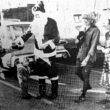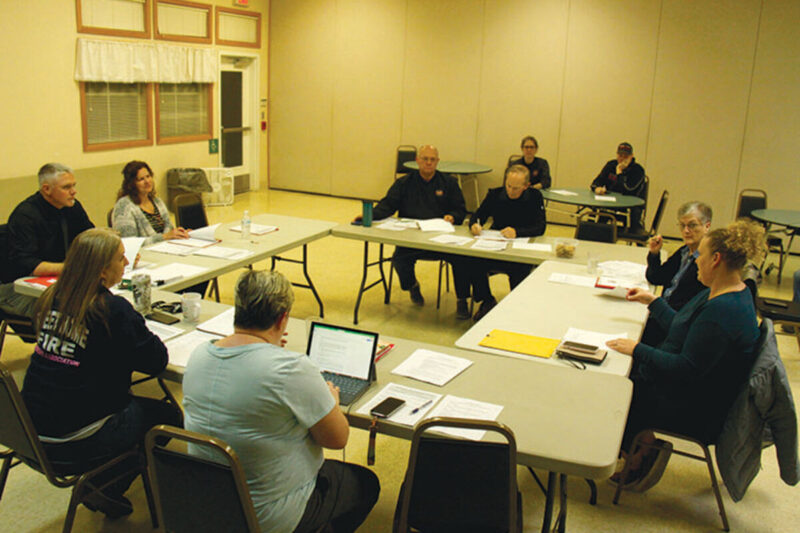Scott Swanson
Sweet Home Fire and Ambulance District is responding to double the calls it did 20 years ago, with fewer total personnel, due to a 40% decrease in volunteer numbers over that period, Fire Chief Nick Tyler told members of the Board of Directors last week.
Speaking at the board’s monthly meeting Tuesday, Jan. 24, Tyler said ambulance and tax revenue, the district’s two main sources of income, are not keeping pace with growth in Sweet Home.
In December, district personnel treated and transported 206 patients, a 62% transport rate, to local hospitals. Turnaround time at hospitals has improved, he said, adding that ambulances have been getting back into service faster in the last month.
Tyler reported that the district received a total of 3,340 calls during 2022, averaging 9.2 per day.
Of those, 2,926 were emergency medical service calls and 422 were fire calls.
He said he decided to “go back and look at historical data to really see what type of increase that is.”
In 2012, 10 years ago, SHFAD had 2,367 calls, about 6.5 per day.
Tyler said he also factored in staffing – in 2022 the district had 14 full-time employees, 10 part-timers and 30 volunteers, a total of 54 personnel.
Ten years ago, he said, full-time staffing was 10, with 10 interns or reserve volunteers, and 41 volunteers, a total of 61 staffers.
In 2002, based on review of numbers culled from “books and hand-written logs,” the district had 1,670 calls, averaging 4.6 per day, with personnel numbering eight full-timers, six interns/RVs, and 50 volunteers, for a total of 64.
“So to say that differently, in the last 10 years, since 2012, our call volume has increased 41.45% and our career staffing has increased 40%,” Tyler said. “The part-time, in terms of RVs, remains at net zero and we’ve lost 11.5% of our volunteer force.
“Taking those same numbers and going back to 2002, our call volume has increased by 100.48%, we’ve increased our career staffing by 75%, our part-time or intern/RVs have increased by 55% and we’ve lost 40% of our volunteers since 2002.”
Tyler said he then projected those numbers forward to determine that the district will likely be running 4,736 calls by 2032, for a total of 13 a day.
He added, “If we continue that trend, we will have increased our staffing to 21 career members, we will still have 10 part-timers, and we will be down to 26 volunteers.
“So it’s bleak. For me, it’s really concerning, one, in order to get to 21 full-time members, where we’re going to come up with the financing for that as we continue to lose volunteers.”
Tyler said the district is working on a marketing plan to recruit volunteers and he told board members “you’ll be seeing a big volunteer push within the community shortly.”
He said the district plans to reach out to local businesses and “build relationships” with employers of volunteers so that, when there’s a call requiring volunteers, there will be a “partnership” in which an employer can release an employee to respond to the emergency situation.
Tyler also said he plans to go to the county and ask for a $5-per-day surcharge on campsites to help bolster district revenue.
“In my mind, those people come into our district but they don’t really pay for our services, but they use our services.”
Such a mechanism has the potential to generate some $250,000 annually for the district, Tyler said.
“If they call 911 for services, we don’t see anything to recover costs for that unless we transport them,” he said. “If somebody camps up on the pass and they go to Blue Pool, those calls are very long calls. That requires a lot of resources. I think it’s beneficial for the district to try to get some of that recovered.”
Tyler said the district is planning to buy a couple of new vehicles, but due to two complaints against the district filed in January with the Bureau of Labor and Industries (BOLI), he plans to hold off on purchasing those until SHFAD’s position becomes clearer.
He said he couldn’t give more specific details about the nature of the complaints, but said the district will respond by a Feb. 14 deadline and “our attorney said that somewhere between six and 11 months after that is when we will hear the ruling on that.”
He said the decision to hold off on the purchase of vehicles is “a worst-case scenario.”
Board Member Rob Younger asked what the difference was between a BOLI and a workman’s compensation complaint.
Tyler and Assistant Chief George Virtue, who manages Weyerhaeuser’s Santiam Lumber Mill, explained that workman’s comp claims tend to involve workplace injuries, whereas BOLI claims usually involve overtime pay issues and, as Virtue put it, “a work practice – something that happened in the workplace.”
Tyler also told the board that the district will likely need to ask voters to approve another bond in the May 2024 election. He said voters will likely be asked to simply continue the six-year $1.575 million levy approved by voters in 2016.
“I really would like to get out of having to rely on bonds to purchase new apparatus and stuff like that, but we just aren’t there yet,” he said. “Those alternative funding sources aren’t in place yet.”
Tyler said that three ambulances will need to be replaced over the life of another bond and one fire engine will also go out of service during that period.
Also, he said, he believes the district needs a training facility to prepare SHFAD personnel to respond to fires in the three-story apartments that are “sprouting up” around Sweet Home.
“I feel woefully inadequate in how we respond to a fire on the third story in an apartment complex as of right now, and not that we have firefighter issues, but we don’t have a way to train them.”
He said the cost of constructing a training facility would likely be about $1.5 million.
“I don’t see a way in the next six years that we’re going to pay for those needs out of budgets,” Tyler said.
Responding to board members’ questions, he said that he has considered using other departments’ training facilities, but Lebanon tore its training tower down and the closest, currently, is in Corvallis because Albany does not have one,
“I don’t even know how much it would cost in overtime to get people to and from there and cover the district and everything else,” Tyler said regarding the logistics of training in Corvallis. “It’s not overly viable. Lebanon would have been difficult, but at least that was 15, 20 minutes away, not an hour.”
Board Member Larry Johnson asked whether it might be feasible to go together with Lebanon Fire District in a training facility, such as at the Lebanon station located next to the Santiam mill.
Tyler responded that he would “definitely have this conversation with (Lebanon Chief) Joe (Rodondo), adding that land might be available at that location.
In other action, board members:
— Voted unanimously to accept the resignation of Board Member Tim Geil, who wrote a letter of resignation dated Dec. 31, stating that he “enjoyed my time on the board and appreciate the hard work and chievements the board has made.” The letter did not state why Geil was resigning.”
Tyler noted that Geil had served on the board for 20 years, since 2003.
Board President Dawn Mitchell noted that Geil’s Position No. 1 is up for re-election in the May 16 election, along with Charlene Adams, Position No. 2, and Larry Johnson, Position No. 3.
According to the Oregon Secretary of State’s elections office, Feb. 4 is the first date to file a declaration of candidacy and March 16 is the deadline to file for the May election.
— Heard from Kori Sarratt, of Accuity Auditing, who presented the 2021-22 fiscal year audit findings.
Sarratt said the district had a “bumpy year from an accounting standpoint.”
She credited the district’s new bookkeeper, Erica Baham, with “doing a great job” and that the district was moving forward.
The district, Sarratt noted, had one over-expenditure, “a compliance issue” that had to do with the payment of personnel expenses from grant funds, “but in the grand scheme of things that was the only thing that came out of a bumpy year. It’s OK.” She said the problem was due to the district “not having enough information in the right timeframe.”
“We haven’t seen an over-expenditure in several years and Julie (Mayfield, assistant to the chief) is really diligent about watching that.”
— Voted to re-approve the November financials after Adams reported that an error had been made on the cash balances, which should have been $1,591,368.04, she said. Adams reported that district income on Dec. 31 was $390,209.92. Expenses were $647,502.76. Total bank balances were $2,247,131.33 for checking and cash balances of $2,201,763.05, following the closure of a $74,267 CD.
— Heard from Battalion Chief Shannon Pettner that work is being completed on safety devices for the fire station’s bay doors that will return the doors to an open position if they hit something as they shut.
She also reported that upgrades to the fire station’s kitchen are being completed, with new stoves and ovens and new refrigerators being installed.





